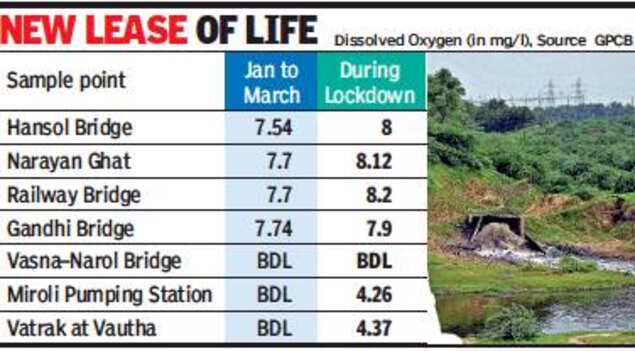
AHMEDABAD: For the first time in decades, the Sabarmati has begun to breathe without painful gasps. According to the Gujarat Pollution Control Board (GPCB), the river can now support life because of the increased dissolved oxygen (DO) levels.
For years, the Vasna-Narol sewage flow of the municipal corporation — a concoction of municipal and industrial toxic waste — had been robbing the river of its DO. That is a key component to support life. The sewage increased the chemical oxygen demand (COD) and the biological oxygen demand (BOD), both detrimental to life.

Though DO levels have increased all along the Sabarmati’s course in Ahmedabad from Hansol, at the Vasna-Narol sewage outfall the DO levels dip below the desired levels. But here is the miracle. At the tail end of the Sabarmati near Vautha and Vatrak — which was the seventh most polluted river stretch in the country — the river resurrects with a fourfold DO level spike at 4.37 milligram per litre (mg/l). And at Miroli petrol pump, the DO level rises to 4.26 mg/l. These figures have been revealed in the latest Central Pollution Control Board (CPCB) report.
River water good enough for holy dip
Legend has it that a ritualistic dip in the Sabarmati at Vautha village in Dholka taluka on Kartika Purnima can absolve one of all sins. Never have the river waters there been so inviting for devotees.
BOD levels — indicating the amount of decaying organic matter — was measured up to 147 mg/l at Vautha, according to the National Green Tribunal report of 2018. The figure was 31 mg/l, as measured by the GPCB, before the lockdown. The permissible limit set by the CPCB is 3 mg/l. Today, the BOD levels at the same spot is 12 mg/l “Some industries are operating as they come under essential manufacturing, so we now know the nature of chemicals pumped in by them,” said a senior GPCBofficial. “Plus, there is municipal sewage too. But we now have a reference point for the Sabarmati and any deterioration in its health can help us nab the culprits.”
For years, the Vasna-Narol sewage flow of the municipal corporation — a concoction of municipal and industrial toxic waste — had been robbing the river of its DO. That is a key component to support life. The sewage increased the chemical oxygen demand (COD) and the biological oxygen demand (BOD), both detrimental to life.

Though DO levels have increased all along the Sabarmati’s course in Ahmedabad from Hansol, at the Vasna-Narol sewage outfall the DO levels dip below the desired levels. But here is the miracle. At the tail end of the Sabarmati near Vautha and Vatrak — which was the seventh most polluted river stretch in the country — the river resurrects with a fourfold DO level spike at 4.37 milligram per litre (mg/l). And at Miroli petrol pump, the DO level rises to 4.26 mg/l. These figures have been revealed in the latest Central Pollution Control Board (CPCB) report.
River water good enough for holy dip
Legend has it that a ritualistic dip in the Sabarmati at Vautha village in Dholka taluka on Kartika Purnima can absolve one of all sins. Never have the river waters there been so inviting for devotees.
BOD levels — indicating the amount of decaying organic matter — was measured up to 147 mg/l at Vautha, according to the National Green Tribunal report of 2018. The figure was 31 mg/l, as measured by the GPCB, before the lockdown. The permissible limit set by the CPCB is 3 mg/l. Today, the BOD levels at the same spot is 12 mg/l “Some industries are operating as they come under essential manufacturing, so we now know the nature of chemicals pumped in by them,” said a senior GPCBofficial. “Plus, there is municipal sewage too. But we now have a reference point for the Sabarmati and any deterioration in its health can help us nab the culprits.”

Coronavirus outbreak
Trending Topics
LATEST VIDEOS
City
 Delhi lockdown: People flout social distancing norms in Chandni Chowk ahead of Ramzan
Delhi lockdown: People flout social distancing norms in Chandni Chowk ahead of Ramzan  How a crocodile was rescued in Telangana
How a crocodile was rescued in Telangana  'Stay at home' message passed on by canine squad of bomb detection and disposal unit of Nagpur Police
'Stay at home' message passed on by canine squad of bomb detection and disposal unit of Nagpur Police  Covid-19 crisis: Empty wallets, stomachs and promises, workers in a fix in Chennai
Covid-19 crisis: Empty wallets, stomachs and promises, workers in a fix in Chennai
More from TOI
Navbharat Times
Featured Today in Travel
Quick Links
Kerala Coronavirus Helpline NumberHaryana Coronavirus Helpline NumberUP Coronavirus Helpline NumberBareilly NewsBhopal NewsCoronavirus in DelhiCoronavirus in HyderabadCoronavirus in IndiaCoronavirus symptomsCoronavirusRajasthan Coronavirus Helpline NumberAditya ThackerayShiv SenaFire in MumbaiAP Coronavirus Helpline NumberArvind KejriwalJammu Kashmir Coronavirus Helpline NumberSrinagar encounter
Get the app





